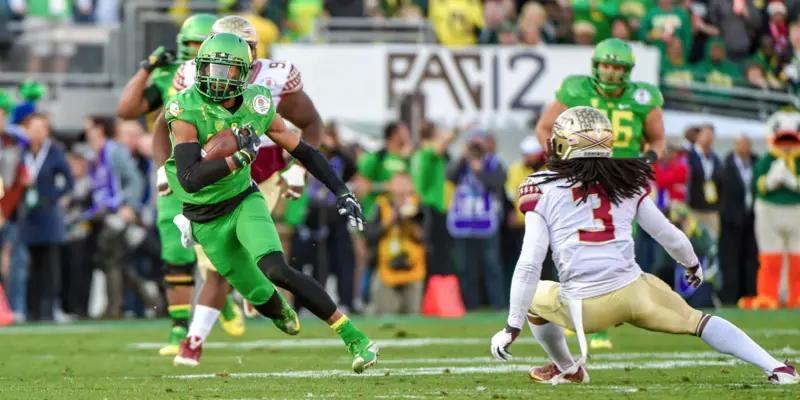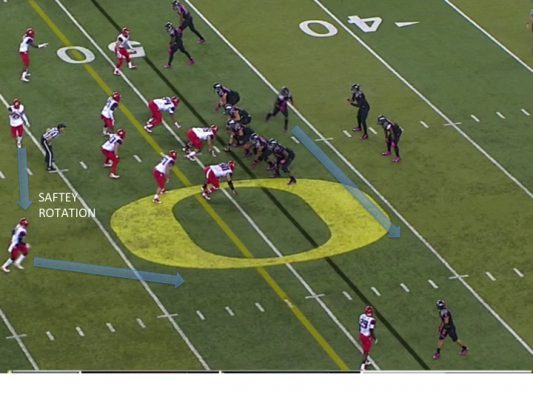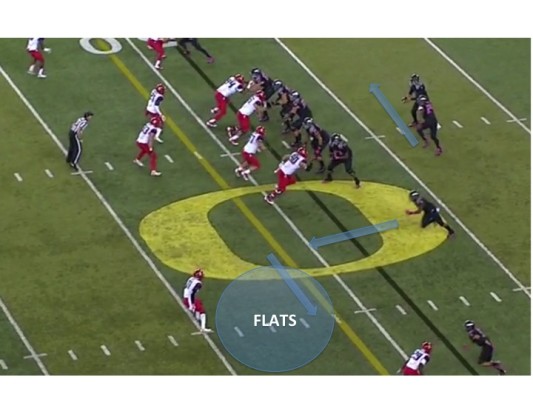Over the past several years college football has become a faster-paced game with a pass-first philosophy. Teams are using this style strategically in order to recruit the best athletes, which lends itself to the ultimate goal: a birth in the College Football Playoff.
The success of the Oregon Ducks is heavily dependent on these concepts: unpredictable running plays within a series, taking advantage of weaknesses in the defensive scheme or a specific defender, and using multiple formations in order to execute any play in the playbook on demand. The use of the Run-Pass Combination enables the Ducks to easily disguise the intent of a specific play.
In the picture above the Ducks align in a basic trips formation. A trips formation establishes three potential receivers on one side of the ball and a single receiver on the opposite side of the ball. At the top of the picture Devon Allen is the single receiver. As Marcus Mariota scans the defense, he will focus on Allen and the alignment of the cornerback, who is playing five yards off the line of scrimmage.
The Run-Pass Combo is a play that is executed based on the movement of the defense. It is established as a result of the defender’s attempt to stop the run, opening up the potential for a big gain through the air. In this case the defender has observed the Ducks execute two straight running plays, which forces him to take notice of the action in the backfield. From the diagram you will notice the space between Allen and the cornerback.
Mariota is intentionally reading the cornerback here. As the cornerback decides to be a run stopper and reacts to running back Thomas Tyner, he leaves Allen wide open. Mariota is precise with his read, pulling the ball from Tyner and releasing it quickly. The next closest defender to Allen is the free safety (13 yards from the football) giving ample space for Mariota to complete the pass.
It’s important to understand that the Ducks do not run plays by chance. There is an intentional plan as to how and why plays are run in a series. Establishing the running game for the Ducks is essential to all of the other functions of the offensive game plan. In the video above you will notice that the Run-Pass Combo is effectively set up.
The first play (above) establishes the running game, with Tyner running the inside zone, forcing the defense downhill to the football. Play two shows Tyner in motion, which forces the linebacker to slightly move to get a better angle to stop the upcoming run. As play one and play two complement each other, Mariota is reading the cornerback on each of these plays to determine if and when the pass read becomes viable.
This is why establishing the running game at a fast pace is vital to Oregon’s success. The defense has approximately 10 seconds to make decisions and opposing coaches feel like they are running a fire drill trying to get the next defensive call in. Meanwhile, the Ducks press on. As you watch the video above, pay close attention to the time on the clock. When Tyner runs for a first down on the inside run, the clock shows 8:34. On the final play of the Run-Pass Combo (the pass play), as the clock shows 8:27. This is amazing, giving only 7 seconds from one play to the next for the defense to adjust, which also enables the success of the pass.
Lets take a look at another video above to show you how the Ducks will attack the defense on the other side of the football using the Run-Pass Combo. Here, Darren Carrington is aware that the corner has a slight inside leverage, so he recognizes that this could possibly be a pass play. From the replay video above shows the corner taking one step forward to stop the run. Carrington then adjusts his route and throttles down to receive the pass. This validates how all of the components to the Run-Pass Combo are executed.
The most important concept with the Run-Pass Combo is to sell the run. After the defense is exposed to the same type of running play over a period of time, they begin to adjust, and when this adjustment is made, it enables Oregon to execute specific passing plays. Each run has a complementing pass, but a defense will never know when the pass is coming because the Ducks camouflage their plays so well.
Take a look at the diagram above. Here you will see Byron Marshall in motion. He will run a quick out route for a big first down. Notice how Mariota makes a play fake to Tyner to hold the interior of the defense. Due to the high success rate of the running game, all six interior defenders attack the run, which allows more room for the receiver to work his route. On the outside, Allen runs a vertical route, forcing the corner to run with him and clear out the flats. On the backside, the receivers are running “get open” routes across the middle trying to find gaps in the defense.
Watch how the safeties in the above diagram rotate to defend the motion. The purpose of the motion helps Mariota to recognize the coverage the defense is playing. In this case, they are Cover 1 Man Under. This a coverage that predicates the defense matching up in man coverage from sideline to sideline, with one free safety covering the middle of the field.
In the above image, Marshall is in motion, forcing the safety rotation, which helps Mariota recognize the Cover 1 Man Under alignment.
Tyner (on the run fake) draws all six interior defenders, while Marshall attacks the flat area by running the quick out.
FINAL THOUGHTS & RE-CAP
The Run-Pass Combination is not a new idea. There are several college football teams that use this exact strategy, but the main difference for the Ducks is their ability to place athletes in successful positions. The way the Ducks practice is essential for their overall success. The blend of pace and the success of the Oregon running game makes the Run-Pass Combo truly lethal for opposing defenses.
I may be in Kentucky, but “oh how we love to learn about your beloved Ducks!”
Jeremy McGuire
Oregon Football Analyst for CFF Network/FishDuck.com
Lebanon, Kentucky
Top Photo by Craig Strobeck
In his tenure as football coach he has had the opportunity to coach in 5 State Championships, winning 3. As the high school game continued to change, Jeremy began to study the Ducks style of play beginning in 2007. Jeremy took some time away from High School football to begin a career in School Administration. Football was never far from his thought as he continued to help local High School Coaches with game planning. After spending 5 years in School Administration Jeremy had the opportunity to start a Graphic Design program and get back into High School full time. Relocating to Lexington, Ky. Jeremy began coaching at Frederick Douglass High School. Jeremy was able to fulfill another goal by coaching his own son who is also a member of the Douglass Broncos. Over the past two years, this 6A powerhouse has a record of 20-4 winning back to back District Championships. His career has come full circle as he is now calling the defense for the Freshman team that is made up of over 30 players each of he 2 years he has coached. He also stays with his roots and works with skills players on offense for JV and Varsity. There are over 95 players on the Frederick Douglass team where Core values are at the center of their success.
As a former Campbellsville University quarterback, and over 20 years of coaching experience he is excited to provide football analysis with the FishDuck team.





